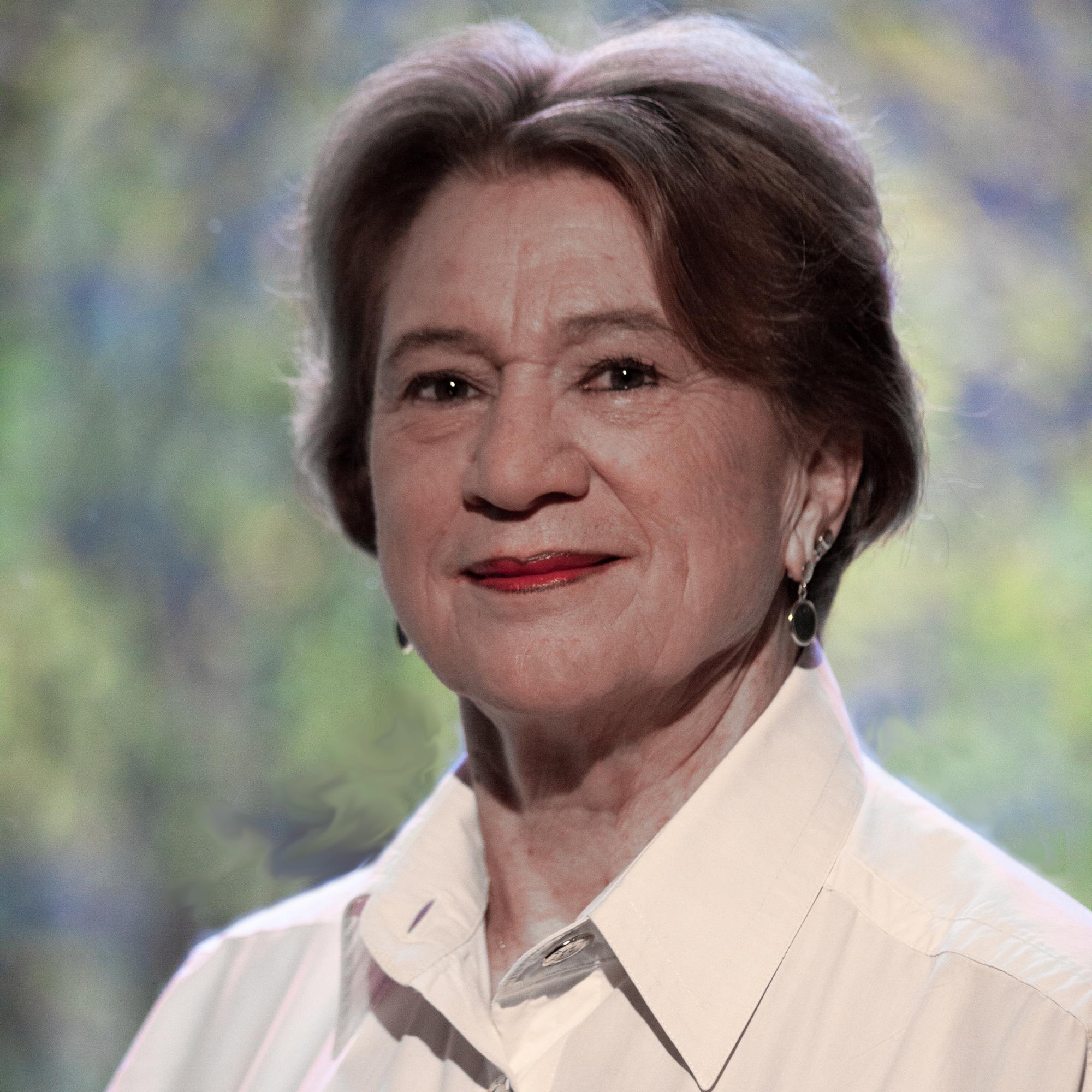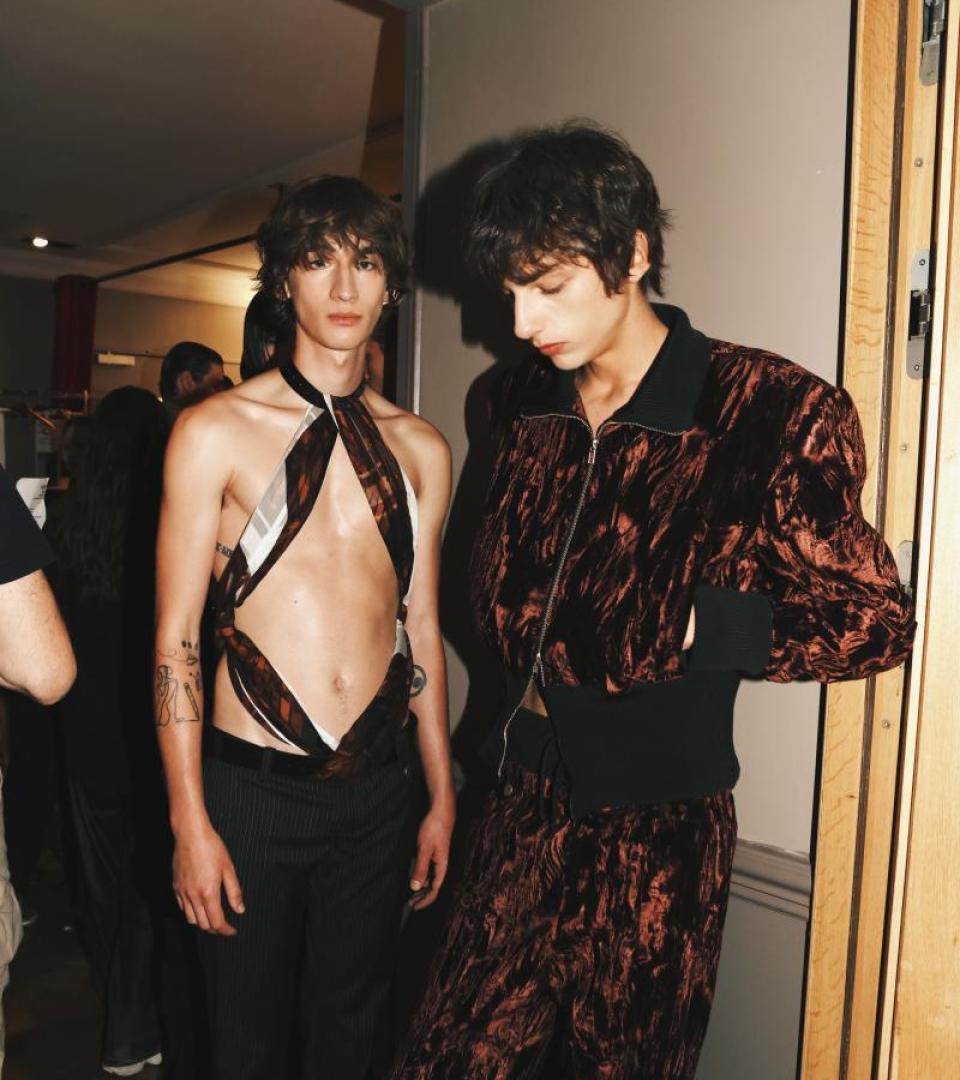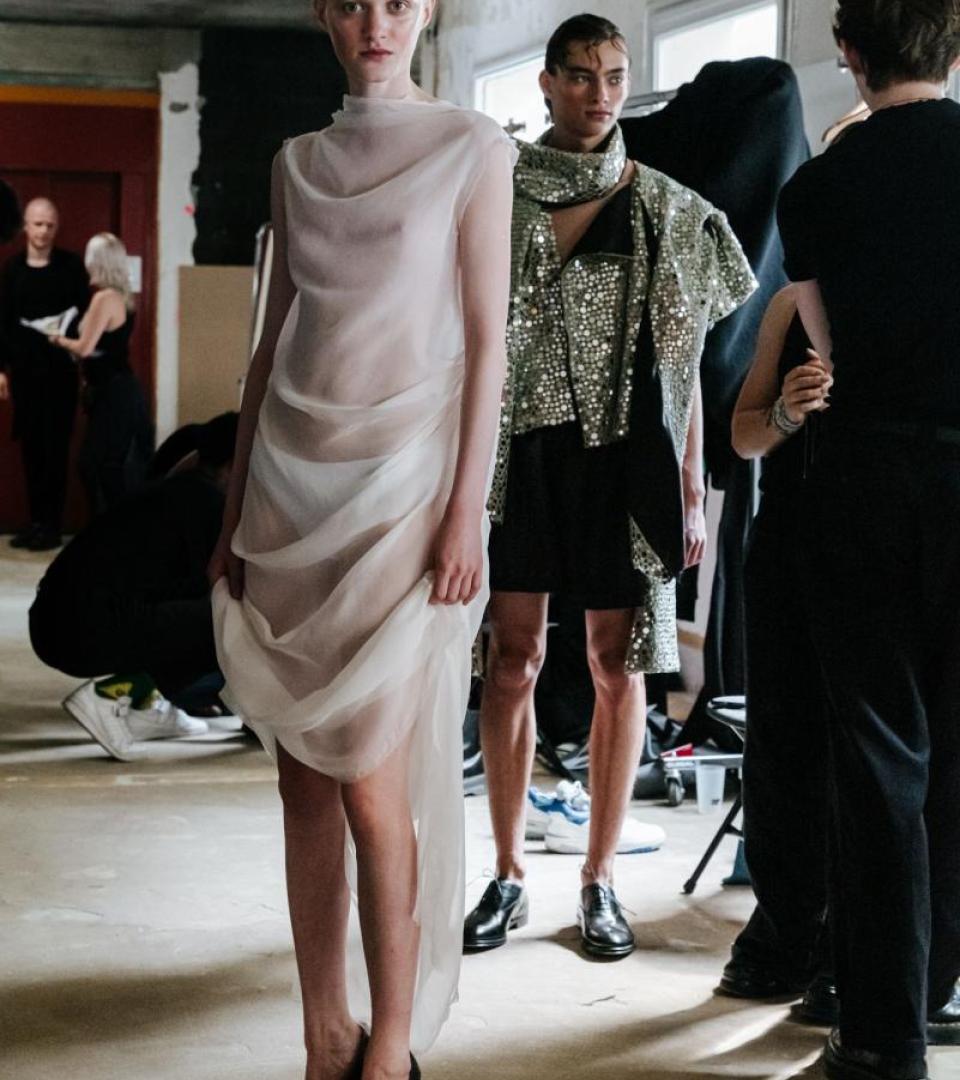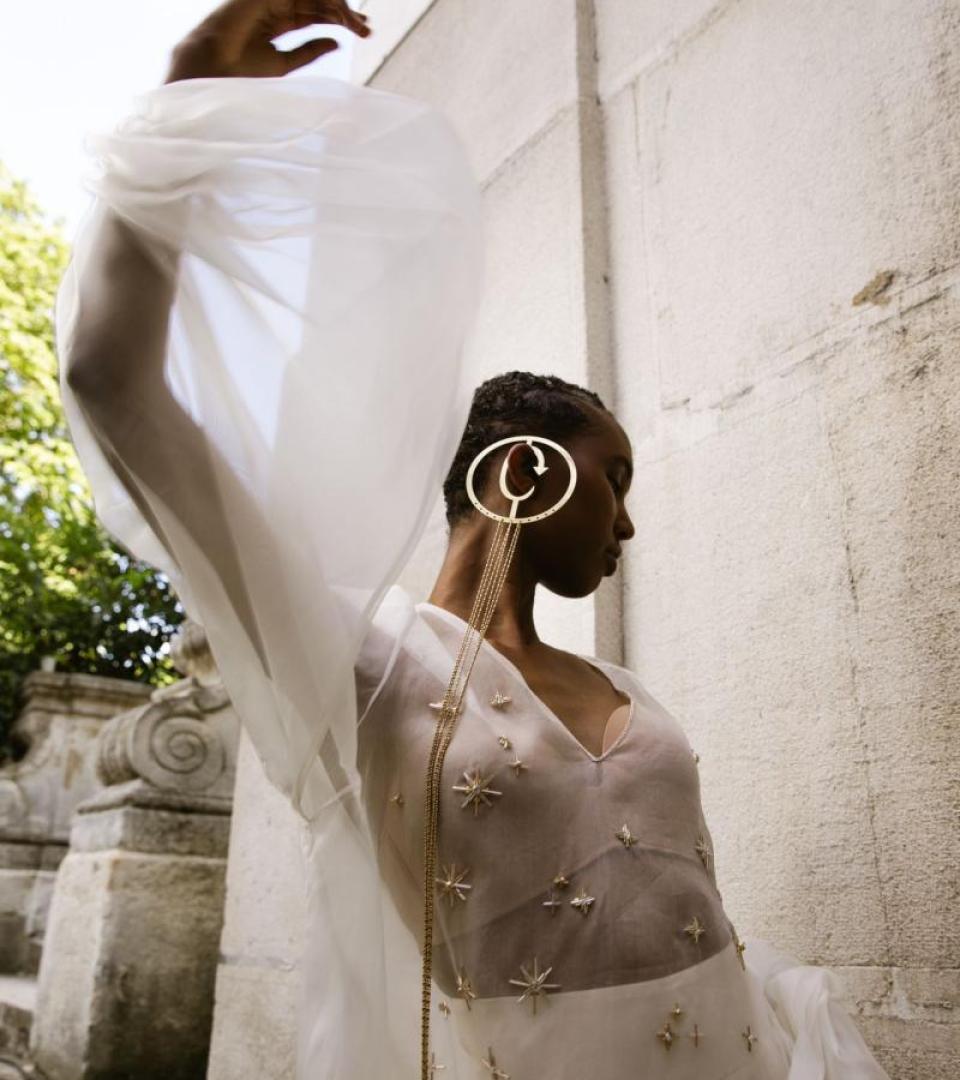Colette Maciet, an exceptional path in the wings of Haute Couture
Coco Chanel, Hanae Mori, Karl Lagerfeld, Hubert de Givenchy, John Galliano, Alexander McQueen, Yves Saint Laurent: Colette Maciet has worked closely beside some of the most illustrious names in Haute Couture. She joined Chanel at the age of 14 as a petite main, then became the première d'atelier to these masters. She carefully chronicles her journey in a book entitled “Haute Couture,” with a preface by Inès de la Fressange, and published by Michel Lafon.

©Gilles Maciet
Fashion testimonies are precious. This writing and transmission work is crucial because it allows the facts to be embodied and transmitted. Colette Maciet carried out this work, with the support of her husband: “He gave me a lot of help and encouragement, as did my close circle of friends and family. They told me it was a unique career. Couturiers usually join a fashion house and spend their career there, climbing the ladder little by little,” says Maciet, who did just the opposite.
In France in the early 1960s, school attendance was mandatory until the age of 14. After graduating, Maciet already sensed that the career ahead of her could not be learned academically. “I told my parents I didn't want to go to school anymore, and they said I had to work. I had a choice between sewing and hairdressing.” The choice was quickly made. “My father's sister was working at Chanel as a première main qualifiée and asked if I could come in as an apprentice.” Colette Maciet attended her first job interview at Chanel at the age of 14. “I hadn't even held a needle before going in,” she admits. “I explained that I wanted to work, and that was it! It's incredible, you don't get in like that these days.”
“Mademoiselle Chanel used to say that one learns by doing.”
Gabrielle “Coco” Chanel revolutionised fashion by establishing the timeless codes of feminine elegance. After opening her fashion house in 1915, she moved to 31 rue Cambon in 1918. Success was instantaneous. When Colette Maciet joined the House, Gabrielle Chanel's international reputation had fully blossomed. “I learned by watching others work. Mademoiselle Chanel used to say that you learn by doing.” Maciet observed the seamstresses in action, supervised by "Monsieur Jean” Cazaubon, chef d’atelier tailleur. “Jean was my mentor. He always pushed me,” she says. Maciet progressed and became a première main qualifiée. “Once, Jean asked me to go with him to present a jacket to Mademoiselle. She said, “Jean, I'll stay with the little girl. Then she turned to me and said, ‘You're going to do what I tell you,’ and started cutting.” Of Gabrielle Chanel, Maciet remembers a great rigour and sharp opinions. “Mademoiselle hated darts,” she recalls. “I always used to avoid wearing darts, it's so unattractive,” she adds with a grin. “Mademoiselle would only use soft fabrics like tweed, and we would place the fabric on top of the organza to pull the fabric in by the amount of the darts. It was supple and structured at the same time, without darts. She had found something fabulous.”
On January 10, 1971, Coco Chanel passed away at the Ritz, where she was staying. She was 87 years old. The collection she was preparing at the time was presented posthumously on January 26, 1971 to unanimous acclaim from the French and international press. From then on, the members of the ateliers carried on their work and continued to dress customers, scrupulously applying the ideas and wishes that Gabrielle Chanel had enacted her whole career. “Monsieur Jean then recommended me for a position as première d'atelier at Hanae Mori,” she recalls. In 1977, Hanae Mori presented her first collection in Paris, subsequently becoming the first Japanese Member of the Chambre Syndicale de la Haute Couture. As a première d’atelier at the age of 30, Maciet discovered new techniques, a new approach and perfected her art: “I was in charge of around 20 girls, and I distributed the work. It was the first time I'd done canvases because Mademoiselle didn't do sketches. It was a major shift.”
"Karl's sketches were so precise, clear and detailed".
On September 15, 1982, Chanel issued a press release stating, “The life and imagination of the Chanel haute couture collection will benefit from the artistic direction of Karl Lagerfeld from January 1983.” The House shakes its feathers and restructures itself. “Mr Paquito Sala was appointed to the Tailleur department and I was called to take over the Flou,” says Maciet. Lagerfeld presented his first collection for Chanel on January 25, 1983. The collection opened with three models, three suits, in blue, white and red, and was accompanied by the music of Edith Piaf and Charles Trenet. “I've kept the spirit of Chanel, but I've given it a little up- to-date edge,” said Lagerfeld to the press. The light, the customers, the glitz – and the work. Backstage, Colette Maciet and her teams were busy. "”We were backstage. There's always finishing touches to be done. It was my life, I loved it. I spent a lot of nights working on the collections.”
“Karl was so sharp,” she adds. “Everyone received clear, detailed sketches. We made our canvas. Then, when we presented it to him, he would choose the fabric, the buttons... Then it would go to the production department and it would be distributed… His flaw was that he was never on time." She worked there until 1990. She occasionally received job offers. “Of course, I always turned them down. I don't know if Karl heard these calls, or if someone told him. But he, who had always loved my drapes, suddenly didn't like them any more."
"I styled Audrey Hepburn, Monsieur de Givenchy's close friend."
In 1952, Hubert de Givenchy left Schiaparelli and founded his own fashion house, which joined the LVMH stable in 1988. “I was sad to leave Chanel, but if I had stayed, I would never have met Monsieur de Givenchy. Her voice softens as she mentions his name. “He was so generous, kind and well-mannered. I had to say hello in the morning and if I didn't, the secretary would call to ask if I was sulking,” she recalls, noting that they celebrated Christmas and New Year's Eve. The approach was easy. She stayed with Hubert de Givenchy for 4.5 years as a première d'atelier, discovering and understanding a different creative approach. "I dressed Audrey Hepburn," she recalls. She was a very good friend of Monsieur de Givenchy. Fittings took place in the grand salons, or at Monsieur's home on rue de Grenelle. I once went alone to Switzerland for fittings.
Hubert de Givenchy retired in 1995. John Galliano, a British tornado of creativity, took the reins of the House in a flash. He presented his first show on January 21, 1996, at the Porte d'Auteuil racecourse, and joined Dior in October of the same year. "When John Galliano arrived, everything changed except the teams. I kept my girls," she explains. As première d'atelier, Maciet remembers a pivotal moment: a saturated contrast between Messieurs de Givenchy and Galliano. “Imagine a première main at her table, she has 50 centimetres to work with. When we started doing four-metre-long trains, we had to adapt,” she says. At Givenchy, Colette Maciet then witnessed the arrival of Alexander McQueen. “McQueen knew how to work. He had been a tailor and he knew how to sew. And the sketches he drew were good,” though she recalls that his character was far less gentle than that of the House's founder. “He shouted at everyone," she recalls.
Fashion creation was booming. Vogue Paris described Spring-Summer 1997 Haute Couture Week as a “Big Bang.” Maciet evolved against a backdrop of creative whirlwinds. The collections by Martin Margiela and Comme des Garçons questioned the creation and aesthetics of clothing.
"And Monsieur Saint Laurent said, ‘Take care of Colette, she's the apple of my eye.' "
One morning, the phone rang: “Yves Saint Laurent is looking for a première d'atelier.” Maciet applied promptly and met “Madame Muñoz,” Anne-Marie Muñoz, an emblematic figure at Saint Laurent who was studio director until Yves Saint Laurent's departure in 2002. “On my first day at Saint Laurent, Madame Muñoz introduced me to Monsieur Saint Laurent. He took me into his office next to the studio and said, looking at the Haute Couture director, Take care of Colette, she's the apple of my eye."
Working with Georgette Capelli, chef d'atelier flou, Colette was again introduced to new methods. “Monsieur would put his sketches on the floor and tell us to choose what spoke to us, what we wanted to do,” she remembers. “Once, Georgette and I took the same sketch and our results were completely different.” Bringing a sketch or an idea to life involves perception, reflection and analysis. “I remember making a jumpsuit when Monsieur Saint Laurent had sketched an evening coat. He chose to keep the jumpsuit in the collection. Sometimes, the première d'atelier can change the designer’s idea.
On Monday, January 7, 2002, Yves Saint Laurent held a press conference. Forty-four years after his first “Trapèze” collection, he announced the end of his career. Once he had left, Maciet worked briefly at Jean Paul Gaultier and then at Nina Ricci. “I brought along Martine Perez, who was part of my team at Saint Laurent. I promoted her to seconde d'atelier.” In 2005, they launched Couture & Co Paris, which continued until 2019. “We have worked with several houses, including Givenchy and Dior. When Pierre Bergé founded the Yves Saint Laurent Museum in Marrakech, he turned to Maciet to reproduce pieces including the Saharienne, the Mondrian dress, “I explained to him that it was difficult to recreate something that had been made 30 years ago! A daunting task, but perfectly achievable for someone who has known nothing but meticulousness and detail throughout her career. “The people in the studio were able to find certain patterns. For the little tassels on the safari jacket, we undid those on the model and Mr Bergé had them redone in Marrakech. He knew what he wanted.”
“All the greats are gone,” she remarks after listing the illustrious names that have punctuated her trajectory. The audacious ideas of these greats that she has known were brought to life thanks to the work of the seamstresses and dressmakers, the different crafts that constitute an atelier. The hands that turn sketches into reality and put ideas into motion.



